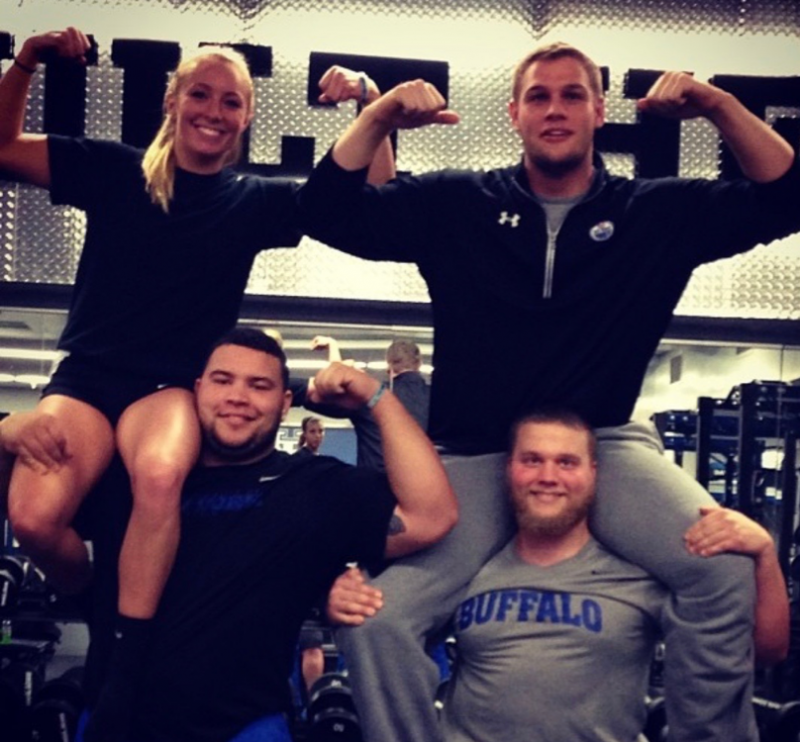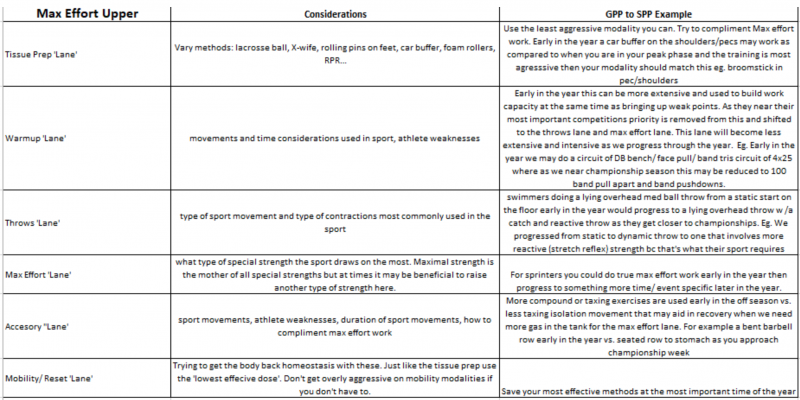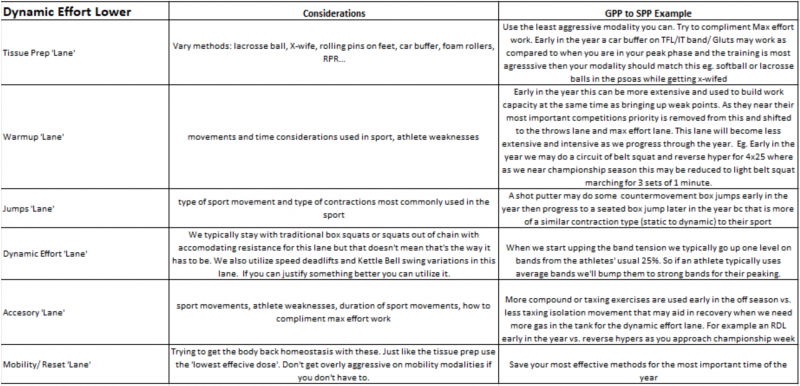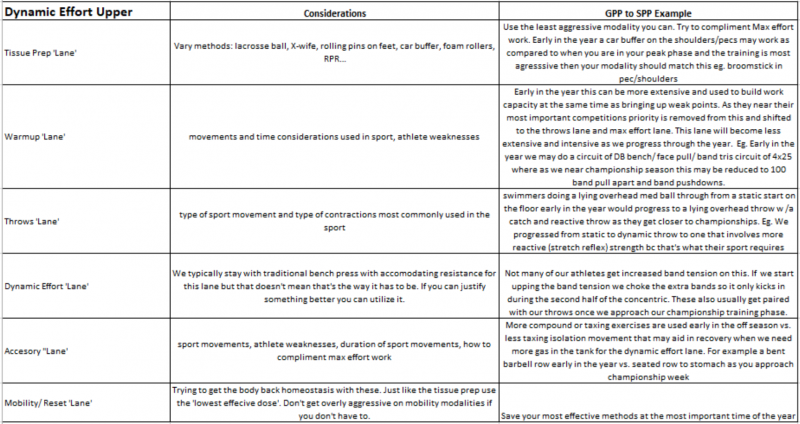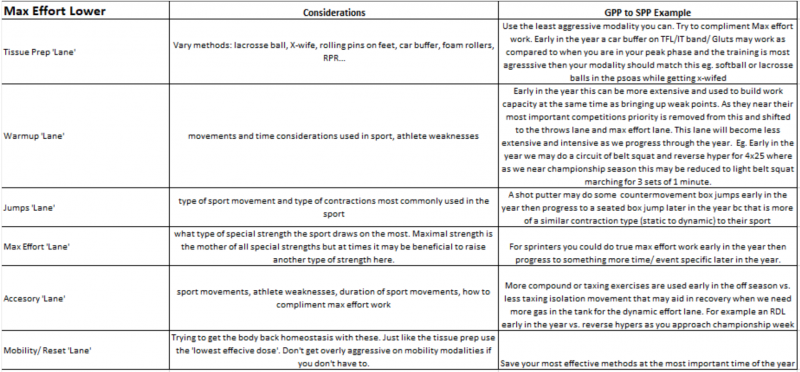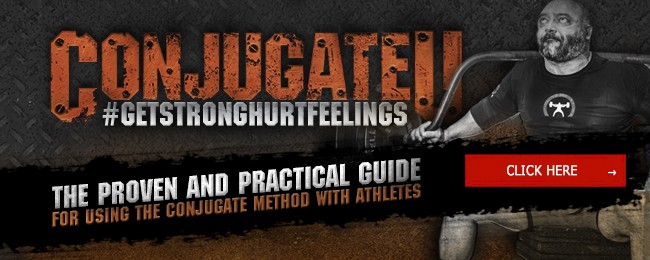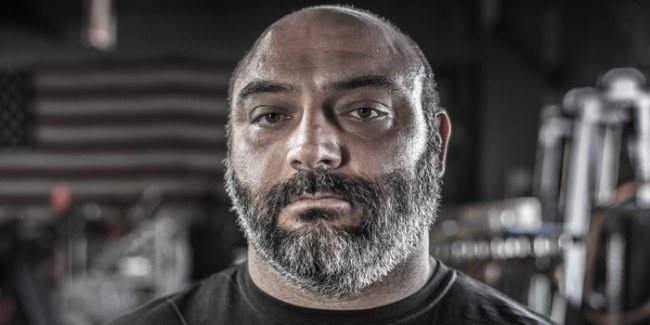
 One of the most frequent questions I get is “How should I adjust conjugate for X sport?” Although there are many ways you can achieve this goal, this article is going to cover what I have found to be the most productive and efficient way to achieve this.
One of the most frequent questions I get is “How should I adjust conjugate for X sport?” Although there are many ways you can achieve this goal, this article is going to cover what I have found to be the most productive and efficient way to achieve this.
Before we go any further, let’s go back to a great Jim Wendler quote...ahhh, damn it… OK...I can’t remember the quote exactly. My memory sucks, and I’m gonna blame it on my many helmet-to-helmet hits from the age of 16-22. I don’t care what ANYONE says about tackling technique...one of my favorite parts of the game was hearing that helmet-to-helmet CRACK. Wait, what were we talking about????? OH, Wendler’s quote…. I can’t remember exactly what he said, but it was something to the tune of “cut away all the bullshit in your life, and set yourself free of all of the stuff that doesn’t help you to get better.” Sorry, Jim, not the sharpest tool in the shed over here. If you don’t believe me, though, take Jim’s word for it!
RECENT: The Waverly Project: Phase II
Aside from not performing movements correctly in the weight room, I think one of the biggest mistakes made with a conjugate system is trying to make it too sport specific. I think it's too common for coaches to think “How can I make this work for MY athletes and their sports?” In the process, what happens is that movements that can't be adequately loaded are put in place, and we lose many of the great benefits of the system. Don't get me wrong—there is a time and a place for everything. Training is very similar to life: if a pendulum swings too far one way or the other, we probably are not doing what's optimal. One of the great things about this system is the work has already been done. You put it in place, you perform movements correctly, and with the correct intent, you will be way ahead of most people. Once you get all of those things down, then you can start getting a little fancy with it, if you’d like. Just remember: don't stray too far from the way. Explain to me how stronger hips, hamstrings, and core—yes, I just said core—more explosive power, the ability to accelerate, improved mobility, more posterior chain work, jumps, throws, and an increased work capacity, all done with very simplistic movements and schemes, aren’t sport specific and I’ll change my mind.
Here is the optimal way to lay this out! Stay in your lane! When possible, do them in this order. I’ve always found it best to keep Max Effort training days as far apart as possible. In season, this might not be possible because you want to do them early in the week to be ready for competitions on the weekends.
When you're filling out these lanes with your movements, keep it simple, and stick with basic movements that are popular in the system. What do we always hear about the top athletes in the world? They hammer the fundamentals. Almost any strength coach you talk to will tell you about “how sh*tty their athletes are at lifting.” If this is the case, then why do we think it’s a good idea to do very advanced movements in the weight room? If you keep it simple and get the right muscle groups strong, you will see huge progress in their performance. Keep the sport-specific movements for practice. You're at the point where more complex accessory work is what your athletes need. A good place to put them in is on the dynamic method days. In this way, you can have movements that are loaded with lighter weights on your lighter lifting days, and you can keep your heavier, more taxing movements on max effort days. This is a great way to build recovery into your weekly plan and to let your athletes adapt to the training while dealing with all of the other stressors that high school college and pro athletes have to deal with. This will allow you to turn over every stone in the parking lot in search of a million dollars without getting too far from the roots of the system. Below are some lane suggestions to start with.
Max Effort Upper Outline
1. Accessory lane
a. Use 4-6 movements
b. Use movements from these categories
c. Sets x reps
d. Take each set to positive failure (when form breaks down). The reps are just a guideline. We are trying to fatigue these muscles, especially in the offseason.
e. Max effort days usually have more intensive movements and lower rep range. Example: bent barbell row instead of seated cable rows.
i. Second pressing movement – 3-4 x 5-10
ii. Horizontal row – 3-6 x 8-12
iii. Triceps – 3-6 x 8-12
iv. Obliques or rotational abs – 4x25
v. Shrug variation – 4-5 x 12-20
vi. Scapula and rotator work (shoulder health) – 4-6 x 20-30
vii. Biceps – 3-4 x 10-15
Max Effort Upper Summary
MAX EFFORT UPPER
- Tissue prep
- Warm-up
- Throws
- Max effort movement
- Accessory movements
- Mobility/reset
Dynamic Effort Lower Outline
2. Accessory lane
a. Use 4-6 movements.
b. Use movements from these categories.
c. Sets X reps
d. Take each set to positive failure (when form breaks down). The reps are just a guideline; we are trying to really fatigue these muscles, especially in the offseason.
e. Dynamic days usually have less intensive movements but higher reps. Example: Reverse Hyper® instead of RDL
i. Single leg movement – doesn’t have to be on this day. Just get one in once per week.
ii. Hip extension hamstring – 3-4 x 10-60 (many times we’ll get up to 60 reps on the Reverse Hyper®)
iii. Knee flexion hamstring – ankle weight or banded hamstrings. Ultra-high reps. Start at 100 total, and build up to 300 total over 4-8 weeks. This dropped hamstring issues significantly.
iv. Adductor movement – 3-4 x 20-30. Groiners or Thompson hips.
v. Weighted abs – 100 total
vi. Upper back movement – 3-4 x 10-20
Dynamic Effort Lower Summary
DYNAMIC EFFORT LOWER
- Tissue prep
- Warm-up
- Jumps
- Dynamic effort movements
- Accessory movements
- Mobility/reset
Dynamic Effort Upper Outline
3. Accessory lane
a. Use 4-6 movements.
b. Use movements from these categories.
c. Sets x reps
d. Take each set to positive failure (when form breaks down). The reps are just a guideline. We are trying to really fatigue these muscles, especially in the offseason.
e. Dynamic days, in general, have less intensive movements but higher volume. Example: Triceps pushdowns as opposed to a fat bar JM press.
i. Horizontal row – 3-6 x 12 -20
ii. Tricep – 3-6 x 12 - 20
iii. Obliques or rotational abs – 4x25
iv. Shrug variation – 4-5 x 12-20
v. Scapula and rotator work (shoulder health) – 4-6 x 20-30
vi. Biceps – 3-4 x 10-15
Dynamic Effort Upper Summary
DYNAMIC EFFORT UPPER
- Tissue prep
- Warm-up
- Throws
- Dynamic effort movements
- Accessory movements
- Mobility/reset
Max Effort Lower
4. Accessory lane
a. Use 4-6 movements
b. Use movements from these categories
c. Sets x reps
d. Take each set to positive failure (when form breaks down). The reps are just a guideline; we are trying to really fatigue these muscles.
e. Max Effort days usually have more intensive movements lower reps. Example: good morning instead of back extension.
i. Second barbell movement – 3 x 5-8
ii. Single leg movement – doesn’t have to be on this day. Just get one in once per week.
iii. Hip extension hamstring – 3-4 x 10-60 (many times we’ll get up to 60 reps on the Reverse Hyper®)
iv. Knee flexion hamstring – 3-4 x 6-12
v. Hip flexor movement – 3-4 x 20-30. Hanging knee raise or weighted knee raise, for example.
vi. Weighted abs – 100 total
vii. Upper back movement 1. Usually a pull/chin-up variation – 3-4 x 6- fail
Max Effort Lower Summary
MAX EFFORT LOWER
- Tissue prep
- Warm-up
- Jumps
- Max-effort movements
- Accessory movements
- Mobility/reset
Conjugate is NOT sport specific: it’s ATHLETE specific. Pretty sure we put the sport-specific myth to bed a few years ago. In the picture below, we have Jon Jones, our 320-pound national champion in the shot, and Kelly Trupo, who was a national level pole vaulter coming in at an approximate whopping 120 pounds. My point is, they used basically the same workout. The major differences are that Jon did more volume on accessories as well as less volume, different jump variations, and more accommodating resistance on his lifts because he was stronger. Save yourself some time and headaches, and program more for your athletes’ lifting ability and focus/motivation in the weight room, not so much their sports. Follow the guidelines laid out above, make sure that your athlete technique and intent are on point, and you can make a bigger difference in your athletes’ performance versus spending hours trying to match sport movements in the weight room. Guaranteed!
